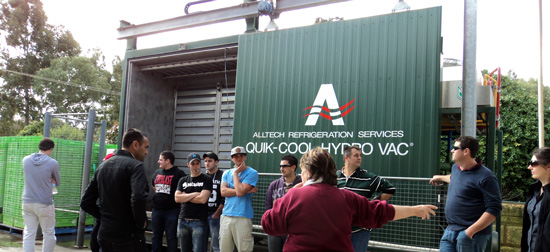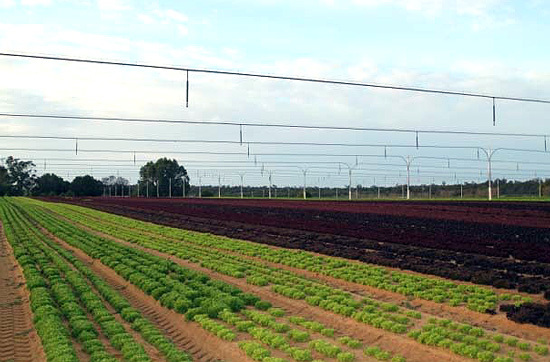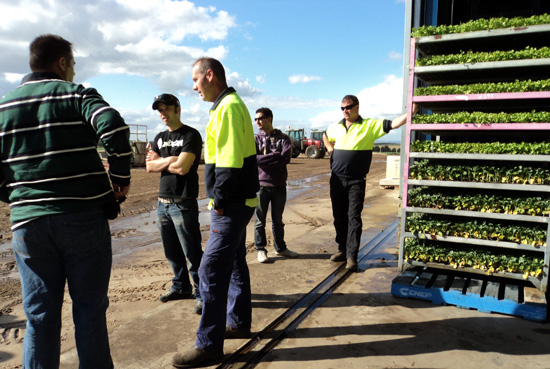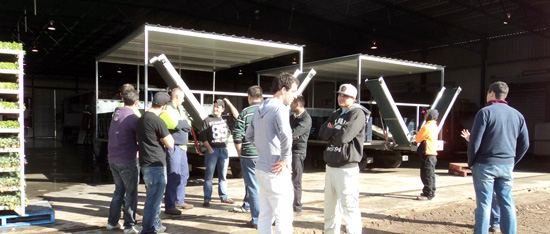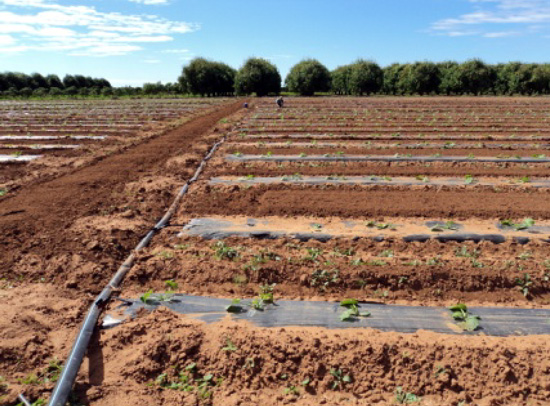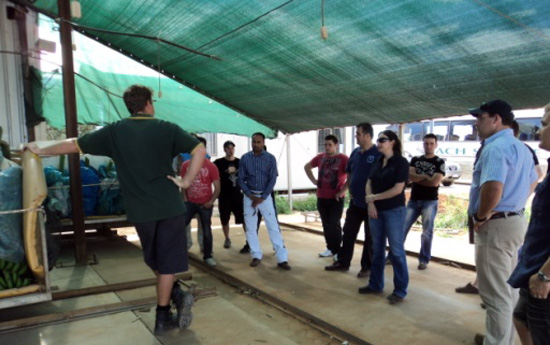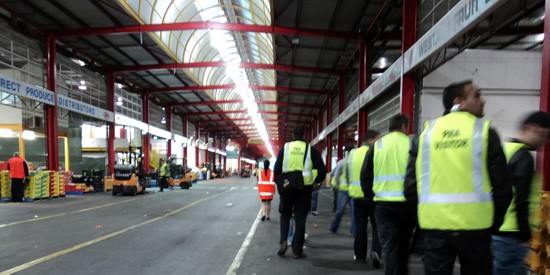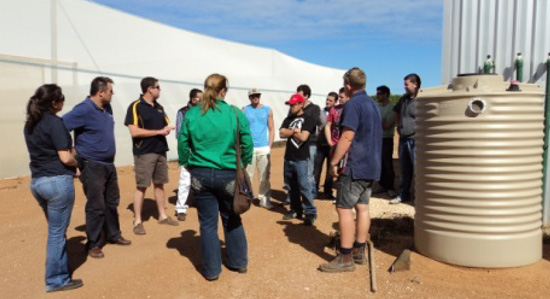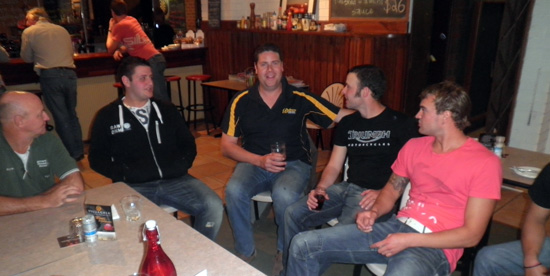|
|
Between 9th – 12th August 2011, ten Victorian growers, aged between 18 and 30, participated in a whirlwind four day study tour to Western Australia visiting farms north of Perth as well as Carnarvon. The purpose of the study which was supported by funding from the Australian Government Department of Agriculture, Fisheries and Forestry under Australia’s Farming Future”, was to look at alternative irrigation systems and new innovations. The growers participating in the study tour came from across Victoria, from Bacchus Marsh to Lindenow and represented conventional, organic and hydroponic growing systems.
The group unknown to each other before the tour all said that the close bond formed over the four days was probably the highlight of the trip. “We hope to keep in touch with each other”, said Daniel, “and form a young grower network that can meet up occasionally to discuss issues.” Day 1: Perth – Gingin – Perth The first farm visited was Farmland Greens. Established in July 2000, this family based company has grown into a major player in the West Australia health food sector. Initially limited to snow pea and sunflower shoots, their range now includes a full selection of the most popular sprouts and shoots. Being a high risk product the sprouts are grown and packed under stringent quality and food safety control conditions.
From planting to harvest takes about 8 days however this requires very strict control and maintenance of temperature and humidity to ensure a uniform, quality crop. Though there are few input costs and all growing containers are sterilised and reused, it is very labour intensive at all stages so labour and electricity costs are very high. Next port of call was The Loose Leaf Lettuce Company where our host was Maureen Dobra. Nestled in the Lennard Valley, approximately 80 km’s north of Perth, The Loose Leaf Lettuce Company grows and packs fresh, gourmet salad vegetables and is one of the horticulture success stories of the Gingin region.
Reversing the often customary practice in the horticulture industry, Barry and Maureen Dobra along with their son Kevan actually inherited the company from Barry and Maureen’s daughters Deanne and Simone. What started as a sideline to meet a client’s request for tiny leaves has developed into a thriving business providing employment for local people and delivering produce six days per week to customers in outer and inner metropolitan areas and to Perth Market City. Around 4 tonne of leaves are harvested each day.
Maureen explained that over the years, they had tried every type of sprinkler head and irrigation system available and had settled on a Nelson turf sprinkler head. On the other property they had experimented with several types of sprinklers but had settled on an overhead travelling system with the jets pointing downward (because of evaporation from high winds). Maureen took the group through the packing operation from harvest to dispatch, explaining that through trial and error, they were now importing much of the machinery used in the field and packing operations. Being unable to find a truck suitable to carrying produce from their other farm to the packing shed because of the road and sand conditions they finally bought a truck from Czechoslovakia. To improve efficiency and reduce costs they installed their own carton folding machine brought from Germany and crate washing area. The business had been increased year by year as funds allowed, doubling production area annually until finally running out of room on the existing block, they recently purchased a further 800 ha to allow for further expansion.
Ante Bogdanich established the Bogdanich Market Gardeners in 1926 following his arrival in Australia. Our hosts were Andrew and Michael Bogdanich who have now expanded the original 20 acre holding in Landsdale with an additional 170 acres in West Gingin where they grow Iceberg and cos lettuce, cauliflower, cabbage, broccoli and celery. They are now growing in excess of 1,000,000 head of lettuce, 200,000 cauliflower and 50,000 cabbage annually.
Day 2: CARNARVON The second day involved a two hour flight to Carnarvon. The Carnarvon Horticulture District is situated on the fertile delta of the Gascoyne River. Despite the fact that the river flows irregularly, and the town is in the middle of 500km of arid landscape, this horticulture district plays an important role in providing fresh fruit and vegetables to the Perth market 1000km away. Crops are grown on micro drip irrigation using water from below ground aquifers. The Carnarvon Horticulture District is considered the best managed irrigation district in Australia. The dry sub tropical climate makes Carnarvon suitable to grow a wide range of temperate, tropical and subtropical produce across the seasons. Around 1000 hectares of land is under cultivation producing a wide variety of fruit and vegetables. Major crops include bananas, table grapes, tomatoes, capsicums, cucurbits, avocados and mangoes. Vegetable production includes Beans, Butternut, Capsicum. Chilli, Cucumber, Eggplant, Sweetcorn, Tomato, Zucchini, Squash and some herbs. The group visited the Agriculture Department site where Chris Shelfout explained some of the irrigation system trials they were undertaking. Then on to visit Wayne Whitcroft, a grower of chillies, zucchini, melons, stonefruit, mangoes and chillies. Wayne took us for a walk through his plantation explaining that nearly all irrigation in Carnarvon was by drip tape under plastic.
Wayne explained that although most properties were only 20ha in size with a few up to 100ha, growers were able to make a reasonable income because of a seasonal window of opportunity. We toured the Sweeter Banana packing shed, a grower owned cooperative. The Carnarvon Banana Industry is about 20% of Australia’s production but supplies 80% of the WA market. Being such a small Australian player, they have been very innovative by necessity in their marketing of bananas to ensure that they get maximum return to growers.
Undersize bananas are being marketed as “Lunch-box” bananas while marked or second grade fruit is bagged as suitable for “Smoothies”. This year had been devastating on several fronts as following the floods the banana trees were severely attached by spur throated locust which stripped many of the leaves that protect the fruit. Another property visited was Bumback’s Plantation where the main crop alongside cucurbits is table grapes grown under net. Mark Bumback explained that due to continuous planting of melons in the same ground biannually, they were now experiencing problems with soil- borne diseases. They were currently trialing a fumigation method using maize and brasicca. Mark also outlined some of the issues that had arisen as a result of the recent floods, the cost and types of netting used. The tour finished at Carnarvon Growers Association where we were shown their carton folding machines in operation. Our sincere thanks to Malcolm Jones and Melissa Brady for organizing the grower visits and assisting with other on-ground activities. Day 4: Perth Market The Perth Market Authority (PMA), is a Western Australian Government agency and is responsible for the ownership and management of Market City. The asset, developed in 1989 is situated on 50 hectares of land at Canning Vale, 16km south of the CBD. We were escorted by Anne and Peter and would like to thank them for showing us so comprehensively around the Market.
Market hours are vastly different to those in Victoria with buyers not having access to the floor until 05:30. The Market has a tenant base of twenty three primary wholesalers, and over thirty secondary wholesalers, providores, distributors and food processing facilities, an on-site national and local transport and storage companies, site cleaning, forklift service and refuelling facilities and service providers including pallet and crate hire companies. One of the features of the Market is its waste recycling centre. Agents pay for waste disposal by weight to have organic matter removed, while carton or hard waste is free. The organic waste is then on-sold to a composting company. The WA Crate Exchange is widely used by growers who hire the crates at $10/crate bond + hire fee. The bond is passed back at each step of the supply chain with the end user collecting the final refund. Crates are then sanitised and readied for re-use. We visited Mercer’s repacking facility where small lines are repackaged for retailers – these may be into bags, tray packs or cartons and has the ability to run short lines of produce and change over product quickly. This is labour intensive with most packing done manually. Workshop – Adapting irrigation methods for climate change A workshop on adapting irrigation methods to address climate change was organised for the group starting in Carnarvon, where the group was introduced to a stand-alone automatic system for irrigation and fertigation designed for small to medium horticultural farms.
Chris Shelfout researcher from Department of Agriculture & Food, WA (DAFWA) demonstrated to the group how the system works. Chris said modern crop management is increasingly automated by hi-tech computer-grade equipment, this system allows them to apply optimum amount of fertilizes at the right time, he added another advantage is record keeping, you can go back and compare plant responses with your fertilizer program and make adjustments if needed. Rohan Prince, Irrigation Officer from DAFWA demonstrated a step by step Vegetable Irrigation Scheduling System. This system has been developed to assist vegetable growers in scheduling irrigation for specific crops growing on the sandy soils of the Perth Coastal Plain. He explained that crop water requirements are calculated by system based on the daily evaporation and growth stage dependent on crop factors developed from research and growers experience. The system uses real-time evaporation information from the live weather station network. Our growers were then taken to a demonstration tutorial step by step. Travis Talbot a young grower from Clyde said the system looks user friendly and can be used as a planning tool as well because it includes information such as crop location, plant date, growth stage, approximate harvest date, required watering and watering station. Rohan Prince concluded saying the system enables growers to Apply right It is good for growers, it is good for the environment. Bob Paulin DAFWA shared some of his knowledge on organic carbon with our growers. Bob has been working with the vegetable industry to develop improved production practices that focus on using compost and changing aspects of management to increase soil organic carbon levels and achieve improved productivity. The benefit of improved soil organic carbon levels will also deliver better environmental and social outcomes by reducing reliance on fertilisers and pesticides and making better use of irrigation. Aileen Reid DAFWA challenges growers with her research on future farming and food security in this country. She said that food production will need to increase by 70 per cent by 2050 to feed the world population, with a predicted average temperature to go up and diminishing resources challenging times are ahead of us. Comments from Young Growers : “I love what I do, the message I want to take home is to look after our resources soil and water, keep them healthy for sustainable production”. “I learnt heaps, the Irrigation Scheduling System is an excellent tool that I would like to utilise, it takes the guess out of irrigation. ” Application is web based and will be ideal for people like us and up and coming young growers.” ” If I can activate my irrigation through my smart phone and just apply the right amount of water, it will make my job easy.” Acknowledgments : The participants wish to thank the many individuals and businesses who made this tour such a success. Partial funding was provided by Australian vegetable growers (through the R&D levy). The Australian Government provides matched funding for all HAL’s R&D activities. For more information contact :
|
||||||||||
|


